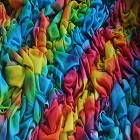"China came out with the 2016 Q1 report of listed printing and dyeing companies recently. The weighted average operating revenue of five representative listed companies reached 362 million Yuan, up 14.89 per cent year on year and net profits scored at 21 million Yuan, up 4.76 per cent year on year. For 6 representative listed dyestuff auxiliary companies, the weighted average operating revenue was 1.034 billion Yuan, down 4.48 per cent on an annual basis and net profits were 101 million Yuan, a fall of 42.77 per cent year on year."

China came out with the 2016 Q1 report of listed printing and dyeing companies recently. The weighted average operating revenue of five representative listed companies reached 362 million Yuan, up 14.89 per cent year on year and net profits scored at 21 million Yuan, up 4.76 per cent year on year. For 6 representative listed dyestuff auxiliary companies, the weighted average operating revenue was 1.034 billion Yuan, down 4.48 per cent on an annual basis and net profits were 101 million Yuan, a fall of 42.77 per cent year on year.
The observation is that the dyestuff auxiliary companies were less prosperous than printing and dyeing companies in Q1 and the growth rate is lower than the latter part.
Performance of printing and dyeing companies

Two among the five listed companies, witnessed operating revenue decrease year on year, while three increased. In Q1, Hangmin remained on top, to increase by 12.51 per cent from last year to reach 675.77 million Yuan. Amid the tight environment policy, capacity of small and medium dyeing plants shrank due to higher dyestuff prices and coming G20 Summit, which was good for the improvement of shares of leading companies. Currently, Hangmin Stock has a capacity of 1 billion meters of printed and dyed fabric and sales ratio is quite good.
MIZUDA and Zhonghe witnessed losses in Q 1, while Hangmin Stock continued to be the top with the net profits of 91.86 million Yuan, up 17.91 per cent. Benefited from higher dyeing fee and good control on cost, net profits increased sharply and the gross profit rate approached 29.44 per cent, up 0.65 per cent from last year.
Dyestuff auxiliary companies dip in turnover Out of the six dyestuff auxiliary companies, three’s operating revenue declined year on year. The leading company, Zhejiang Lonsen witnessed a yearly decrease of 22.58 per cent to reach 2.981 billion Yuan in Q1, as the dyestuff prices began to tumble in Q2, 2015 and rebound after March, 2016. Therefore, the dyestuff prices maintained at a historical low level in Q1, 2016.
At present, Zhejiang Lonsen has the largest dyestuff capacity in China, with 140kt of disperse dyestuff and 70kt of reactive dyestuff per year. In 2015, operating revenue of dyestuff and intermediate accounted for about 70 per cent in total. In 2017, the annual capacity of disperse dyestuff will increase from 140kt to 250kt and in the next 5 years, the capacity of intermediate will rise from 50kt to 150kt.
Net profits move south

A look at the net profits reveal, only one company saw net profits increase year on year and other five companies all decreased sharply. In Q1, net profits of Zhejiang Lonsen reached 304 million Yuan, down 73.95 per cent year on year, as dyestuff prices remained low in the first quarter after the sharp decrease in the second quarter of 2015.
With the tightening of environment policy, high-polluting printing and dyeing and dyestuff companies will be under stringent regulation in general. In printing and dyeing industry, the shutdowns of small and medium plants lead to capacity reduction, so the shares of leading companies are expected to increase further.
Moreover, with the coming G20 Summit, printing and dyeing and dyestuff companies are predicted to be shut down for about 15-20 days. Supply of dyestuff auxiliary is likely to decrease. Though the price increase of dyestuff does not pose positive impact on the Q1 report, the report in Q2 may be better amid the traditional buoyant season.












